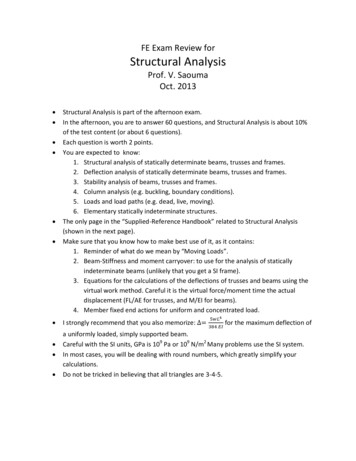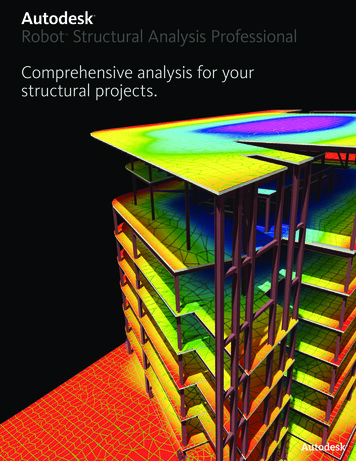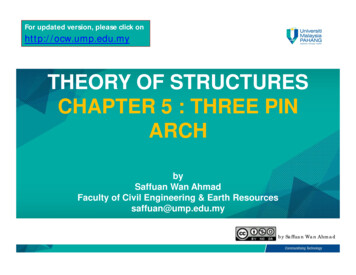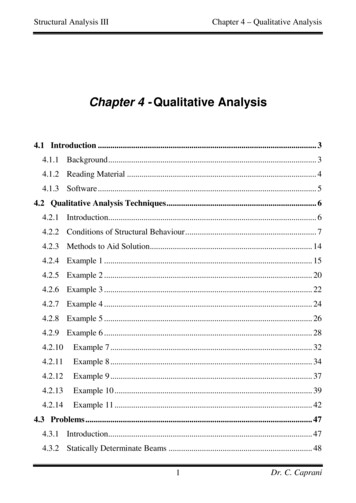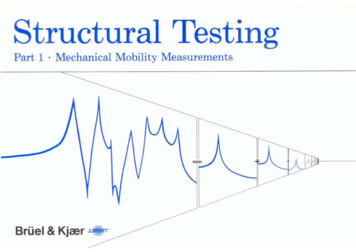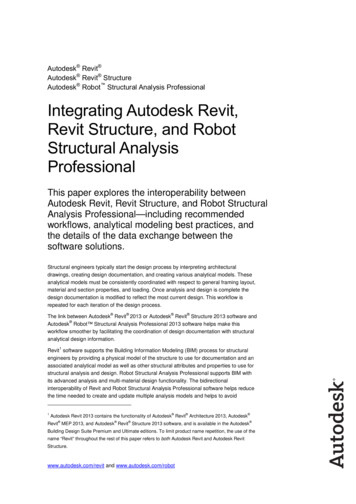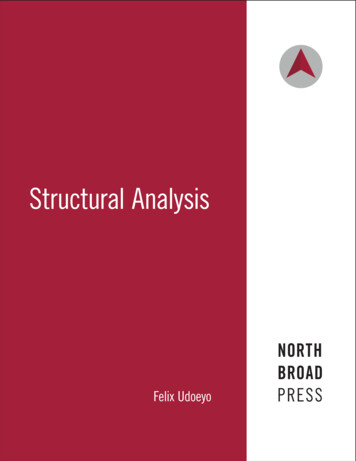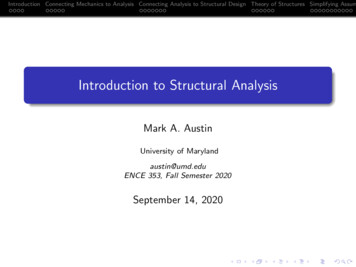
Transcription
Introduction Connecting Mechanics to Analysis Connecting Analysis to Structural Design Theory of Structures Simplifying AssumIntroduction to Structural AnalysisMark A. AustinUniversity of Marylandaustin@umd.eduENCE 353, Fall Semester 2020September 14, 2020
Introduction Connecting Mechanics to Analysis Connecting Analysis to Structural Design Theory of Structures Simplifying AssumOverview1IntroductionCourse Introduction2Connecting Mechanics to Analysis3Connecting Analysis to Structural DesignConnecting Analysis to Structural Design4Theory of StructuresStatically Determinate and Indeterminate Structures5Simplifying AssumptionsSmall Displacements, Linear Systems Behavior6Symmetries
Introduction Connecting Mechanics to Analysis Connecting Analysis to Structural Design Theory of Structures Simplifying AssumIntroduction
Introduction Connecting Mechanics to Analysis Connecting Analysis to Structural Design Theory of Structures Simplifying AssumDefinition of Structural MechanicsMechanics. Branch of science that deals with response of matterto forces.Civil Engineering:Structural mechanics (σ - ):material displacement.Geomechanics (σ - ): pressure,temperature, displacements.σFluid mechanics (σ - ): pressure,velocities.Other domains:Biomechanics (σ - ): eye, heart,biological systems that grow!
Introduction Connecting Mechanics to Analysis Connecting Analysis to Structural Design Theory of Structures Simplifying AssumStructural Mechanics and AnalysisStructural Mechanics Static / Dynamic Analysis of Structures:
Introduction Connecting Mechanics to Analysis Connecting Analysis to Structural Design Theory of Structures Simplifying AssumStructural Mechanics and AnalysisScope of this class:We will be concerned with structural systems that areattached to the ground.Pathway forward:Connect mechanics to analysis .Connect analysis to design .Theory of structural analysis .Statically determinate structures .Statically indeterminate structures .Simplifying assumptions .
Introduction Connecting Mechanics to Analysis Connecting Analysis to Structural Design Theory of Structures Simplifying AssumConnectingMechanics to Analysis
Introduction Connecting Mechanics to Analysis Connecting Analysis to Structural Design Theory of Structures Simplifying AssumStructural Mechanics and AnalysisPyPxABHAVABending MomentVBdeflection: y(x)Internal ForcesCM (x )TElongationShear ForceV (x )Axial ForceN (x )
Introduction Connecting Mechanics to Analysis Connecting Analysis to Structural Design Theory of Structures Simplifying AssumConcrete Beam: Load-to-Failure ExperimentExperimental SetupPyPCxABTHAVAdeflection: y(x)Bending Moment Diagram (BMD)VB
Introduction Connecting Mechanics to Analysis Connecting Analysis to Structural Design Theory of Structures Simplifying AssumConcrete Beam: Load-to-Failure ExperimentApplied Load P versus Midspan DeflectionLoad PIncipient crackingy (x )Patterns of CrackingCTDirection of crackingperpendicular to slopeof BMD.
Introduction Connecting Mechanics to Analysis Connecting Analysis to Structural Design Theory of Structures Simplifying AssumPathway from Mechanics to System-Level BehaviorFrom material-level mechanics to building-system response:Material integrateResponseSection re hiφ(x ) MEI(x )Deflectionσ(x , y )Strain (x , y )Building SystemResponsey (x )Slopedy /dxHow will the integration work?Analytical Procedures: The math needs to be ”nice” .Numerical Procedures: Compute approximate solutions linear algebra, numerical algorithms, structural analysis andfinite elements.
Introduction Connecting Mechanics to Analysis Connecting Analysis to Structural Design Theory of Structures Simplifying AssumConnectingAnalysis to Design
Introduction Connecting Mechanics to Analysis Connecting Analysis to Structural Design Theory of Structures Simplifying AssumFramework for Analysis and DesignCreating an Analysis ModelAbstract from considerationdetails not needed fordecision making.Validate that modelcaptures essential aspects ofreal-world behavior.Decision making needed fordesign.Perfect is the enemy ofgood. Mathematical modeland decision making doesnot need to be perfect inorder to be useful.
Introduction Connecting Mechanics to Analysis Connecting Analysis to Structural Design Theory of Structures Simplifying AssumConnecting Analysis to DesignStructural Design. Sequence of analyses punctuated by decisionmaking.Determine types and magnitudes of loads and forces acting onthe structure.Determine context of project: geometric constraints,architectural constraints, geological conditions, urbanregulations, cost, schedule, etc.
Introduction Connecting Mechanics to Analysis Connecting Analysis to Structural Design Theory of Structures Simplifying AssumConnecting Analysis to DesignGenerate structural system alternatives.Analyze one or more of the alternatives.Select and perform detailed design.Implement/build.Analysis and decision makingprocedures complicated byuncertainties in loading, materialproperties, etc. State-of-the-artmethods compensate foruncertainties with safety factors.New structural systems may also require an experimental testingphase to verify behavior and achievable system performance.
Introduction Connecting Mechanics to Analysis Connecting Analysis to Structural Design Theory of Structures Simplifying AssumConnecting Analysis to DesignReal-World and Idealized Abstractions
Introduction Connecting Mechanics to Analysis Connecting Analysis to Structural Design Theory of Structures Simplifying AssumConnecting Analysis to Design
Introduction Connecting Mechanics to Analysis Connecting Analysis to Structural Design Theory of Structures Simplifying AssumConnecting Analysis to Design
Introduction Connecting Mechanics to Analysis Connecting Analysis to Structural Design Theory of Structures Simplifying AssumTheory of Structures
Introduction Connecting Mechanics to Analysis Connecting Analysis to Structural Design Theory of Structures Simplifying AssumStatically Determinate StructuresDefinition. Can use statics to determine reactions and distributionof element-level forces. Determinacy is not affected by details ofloading.Two-Dimensional ProblemsXFx 0,XFy 0,XMz 0.(1)Three-Dimensional ProblemsXXFx 0,XFy 0,XFz 0.(2)Mx 0,XMy 0,XMz 0.(3)
Introduction Connecting Mechanics to Analysis Connecting Analysis to Structural Design Theory of Structures Simplifying AssumStatically Determinate StructuresExample 1. Simply supported beam:PPABHAVAThree equations of equilibrium:VBPFx 0,PFy 0,PMz 0.Three unknowns: VA , HA and VB Can use statics to solve.
Introduction Connecting Mechanics to Analysis Connecting Analysis to Structural Design Theory of Structures Simplifying AssumStatically Determinate StructuresExample 2. Small truss structure:PPPAPPBHAVAVBUse statics to find support reactions VA , HA and VB .Compute member forces by considering equilibrium ofindividual joints.
Introduction Connecting Mechanics to Analysis Connecting Analysis to Structural Design Theory of Structures Simplifying AssumStatically Indeterminate StructuresDefinition. Statics alone are not enough to find reactions. Needto find additional information (e.g., material behavior).Example 1. Simply supported beam:PPABHAHBVAThree equations of equilibrium:VBPFx 0,PFy 0,PMz 0.Four unknowns: VA , HA , VB and HB 4 3 staticallyindeterminate to degree 1.
Introduction Connecting Mechanics to Analysis Connecting Analysis to Structural Design Theory of Structures Simplifying AssumStatically Indeterminate StructuresExample 2.PPABHAVAVBVCThree equations of equilibrium. Four unknowns: VA , HA , VB andVC 4 3 statically indeterminate to degree 1.Example 3. Multi-material Truss Element.Material AMaterial behavior definedby σ characteristics.Need to maintaingeometric compatibility.PMaterial BP
Introduction Connecting Mechanics to Analysis Connecting Analysis to Structural Design Theory of Structures Simplifying AssumSimplifying Assumptionsfor ENCE 353Small DisplacementsLinear Systems Behavior
Introduction Connecting Mechanics to Analysis Connecting Analysis to Structural Design Theory of Structures Simplifying AssumAssumption 1: Small DisplacementsDefinition. We assume that application of loads will cause adisplacement (i.e., elements are not rigid).Example 1. Axial extension of a RodApply load PPP4LLSmall displacements means 4L L, i.e.,h4LLi1.
Introduction Connecting Mechanics to Analysis Connecting Analysis to Structural Design Theory of Structures Simplifying AssumAssumption 1: Small DisplacementsExample 2. Flexure of Beam igurationaFor steel/concrete structures: a b (i.e., a 0.99b) computeequilibrium with respect to the undeformed configuration.
Introduction Connecting Mechanics to Analysis Connecting Analysis to Structural Design Theory of Structures Simplifying AssumAssumption 1: Counter ExamplesArch Structures. Vintage Safeway Supermarkets.Style: Use mid-century modern arch shape to create large openspaces.
Introduction Connecting Mechanics to Analysis Connecting Analysis to Structural Design Theory of Structures Simplifying AssumAssumption 1: Counter ExamplesNice Trick: When heavy snow loads cause large roof deflections,arch mechanism gives illusion of safety!Google: safeway roof collapse.
Introduction Connecting Mechanics to Analysis Connecting Analysis to Structural Design Theory of Structures Simplifying AssumAssumption 1: Counter ExamplesLarge Geometric Displacements. Wind turbine blades, flexiblerobot arms, etc .Roll cantilever into circle.Source: Simo, Vu-Quoc, 1986.Flexible robot arm maneuver.
Introduction Connecting Mechanics to Analysis Connecting Analysis to Structural Design Theory of Structures Simplifying AssumAssumption 1: Counter ExamplesLarge Material Displacements. Behavior of Lead-RubberIsolators under Large Cyclic Earthquake Loads.Lead-Rubber Laminated BearingSource: Lin W-J., 1997.Hysteresis Loops
Introduction Connecting Mechanics to Analysis Connecting Analysis to Structural Design Theory of Structures Simplifying AssumAssumption 2: Linear Systems BehaviorMathematical Definition. Let k be a non-zero constant. Afunction y f(x) is said to be linear if it satisfies two properties:y f (kx1 ) is equal to y kf (x1 ).f (x1 x2 ) f (x1 ) f (x2 ).For constants k and m these equations can be combined:kf (x1 ) mf (x2 ) f (kx1 mx2 ).(4)Economic Benefit. Often evaluation of y f (x) has a cost.Linearity allows us to compute y1 f (x1 ) and y2 f (x2 ) and thenpredict the system response for kx1 mx2 via linear combination ofsolutions. This is free!
Introduction Connecting Mechanics to Analysis Connecting Analysis to Structural Design Theory of Structures Simplifying AssumAssumption 2: Linear Systems BehaviorExample 1. Consider an experiment to determine the extension ofan elastic chord as a function of applied force.Experimental SetupExperiment 1Experiment 2Experimental AnalysisUnstretched entLinearity allows us to predict solutions:Kx1 F1 , Kx2 F2 , K (mx1 nx2 ) mF1 nF2 .(5)
Introduction Connecting Mechanics to Analysis Connecting Analysis to Structural Design Theory of Structures Simplifying AssumAssumption 2: Linear Systems BehaviorExample 2. Analysis of Linear Structural Systems:Suppose that matrix equations AX B represent behavior of astructural system:Matrix A will capture the geometry, material properties, etc.Matrix B represents externally applied loads (e.g., dead/livegravity loads).Column vector X represents nodal displacements.Solving AX B has computational cost O(n3 ).However, if matrix system is linear, then:AX1 B1 , AX2 B2 A(mX1 kX2 ) mB1 kB2 .(6)
Introduction Connecting Mechanics to Analysis Connecting Analysis to Structural Design Theory of Structures Simplifying AssumAssumption 2: Linear Systems BehaviorWe can simply add the results of multiple load cases:Load Case 1P1Load Case 1 2 * ( Load Case 2 )P1A2P2BVa1Load Case 2Vb1P2Vc 1Vc 2Computation of Support ReactionsABVa2Requires Computational EffortVb2Vc 1 Va1 2Va2Vc 2 Vb1 2Vb2Computation Almost FreeWorks for support reactions, bending moments, displacements, etc.
Introduction Connecting Mechanics to Analysis Connecting Analysis to Structural Design Theory of Structures Simplifying AssumSymmetries
Introduction Connecting Mechanics to Analysis Connecting Analysis to Structural Design Theory of Structures Simplifying AssumTaking Advantage of SymmetryObservation. Symmetries provide engineers with an opportunityto reduce model size and computational effort.Definitions. Here’s what a mathematician would say:A function is even (symmetric) when y f(x) f(-x).Examples: y x 2 and y cos(x).A function is odd (skew-symmetric) when y g(x) -g(-x).Examples: y x 3 and y sine(x).Home Exercise. Show that:Z af (x)g (x)dx 0. aWe will use this later in the course to simplify analysis.(7)
Introduction Connecting Mechanics to Analysis Connecting Analysis to Structural Design Theory of Structures Simplifying AssumTaking Advantage of SymmetryExample 1. Consider the Small Truss Structure:Axis of symmetryworks for geometry,loading patterns andreactions.PaAdcbOnly need to computemember forces a – e.Model reductionrequires carefultreatment ofboundary conditions.PdecbaBHAVAVBAxis of Symmetry
Introduction Connecting Mechanics to Analysis Connecting Analysis to Structural Design Theory of Structures Simplifying AssumTaking Advantage of SymmetryModel Reduction: Cut model size in half, then adjust boundaryconditions along axis of symmetry.PPdPddModel ReductioncbaAecbaBoundary ConditionsBecbaHAVAVBAxis of SymmetryVB
Introduction Connecting Mechanics to Analysis Connecting Analysis to Structural Design Theory of Structures Simplifying AssumTaking Advantage of SymmetryExample 2. Stress Analysis in Cross Section of a Long Pipe
Introduction Connecting Mechanics to Analysis Connecting Analysis to Structural Design Theory of Structures Simplifying AssumTaking Advantage of SymmetryTwo axes of symmetry for geometry and loading Only need toanalyze 1/4 of the cross section.Stresses: σyy (x, y )Stresses: σxx (x, y )
Introduction Connecting Mechanics to Analysis Connecting Analysis to Structural Design Theory of Structures Simplifying AssumReferencesWane-Jang Lin, Modern Computational Environments for SeismicAnalysis of Highway Bridge Structures, PhD Thesis, University ofMaryland, College Park, MD, 1997.Simo J.C., Vu-Quoc L., On the Dynamics of Flexible Beams UnderLarge Overall Motions—The Plane Case: Part II, Journal of AppliedMechanics, (53) 4, 855-863, 1986.
Introduction Connecting Mechanics to Analysis Connecting Analysis to Structural Design Theory of Structures Simplifying Assumptions Symmetries Introduction to Structural Analysis Mark A. Austin University of Maryland austin@umd.edu ENCE 353, Fall Semester 2020 September 14, 2020.

